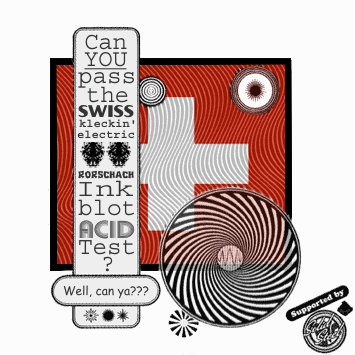Rorschach Inkblot Acid Test
“One flew east, one flew west,
what the hell is a Rorschach test?”
The Rorschach Inkblot Acid Tests were a series of Swiss experimental art showcases that mixed mind-altering music with controversial psychoanalytical procedures to determine emotional functionality using a combination of high-grade hallucinogens and random splotches of india ink. These straight-up, out-and-out freak-fests were described in Schaffhausen art critic circles as "utterly over-hyphenated" and "Psychedelianalytic Apostrophemotions", not because it made any sense, but because Mary Poppins is huge in Switzerland and really anywhere that favours the hot nanny archetype.
Originally called The Swiss Kleckin' Electric Rorschach Inkblot Acid Test, the title was later shortened because brevity is the soul of Switz. Well, that and cowardice. Though many cutting-edge artists contributed to the overall lunacy of these events, the head mastermind of madness was Hermann Rorschach, Zürich's inkblot extraordinaire and the grandaddy of great Dada.
Dude, Where's My Art?
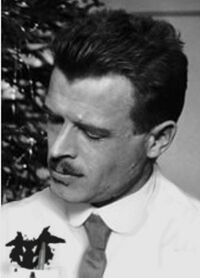
An analytical child, Hermann Rorschach had little interest in Corgi cars or Gruyère building blocks, opting to spend his time playing word association games with his favourite stuffed bear, Sir Bon Yvorne III, and placing his friends under hypnosis to increase their level of suggestibility, at which point he would make 'em fork over their lunch francs.
Watching his father struggle as a not quite starving, but certainly malnourished, artist forged Hermann's path in the field of psychiatry, where the real money was. While attending university, he needed some extra cash and took a job at a sanitorium testing the hallucinogenic properties of Blau Geiss, Hoch Ybrig, and other funny sounding artisanal cheeses for the Swiss Army, who were trying to branch out into other areas of ingenuity after crafting the world's leading pocket-sized knife/screwdriver/nail file/smaller knife/scissors/shiv/toothpick/can opener/magnifying glass/hypodermic needle/even smaller knife/corkscrew/awl/deluxe pen set/one other knife that really has no use/tweezers/toenail clippers/fish hook combination.
After getting bombed on Forsterkäse in the asylum late one night, he explored the voluntary wing of the hospital and started up a conversation with a former Swiss Miss Beauty Pageant runner-up who had lost the competition and a bit of her mind due to her inability to yodel or make even a halfway decent fondue. As Hermann began to ascend the Matterhorn of his cheese trip, his blonde companion pointed to his shirt pocket in which his biro had burst and said, "Hey, that ink stain looks like a butterfly bearing the burden of my innumerable failures."
In those fifteen words an idea, a really insane visual of a giant clock made of daffodils, and the end of this chapter, were born.
Turn On, Tune In, What Might This Be?
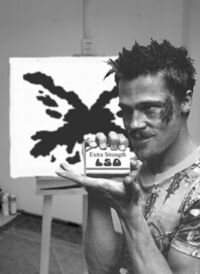
Needless to say, the psychedelic experience changed Rorschach's worldview and he no longer cared about making vast amounts of money, opting to become an artist and smear ink symmetrically on canvas because, as he now realized, artists get way more poon. The nature of his medium enabled him to produce a vast body of work in a short period of time and he began to exhibit his inkblots throughout Switzerland. It was in a gallery in Baden that he met a young, radical chemist and social activist named Albert. Al was staring intently at a piece called Italy Kicking A Derby Hat While A French Maid Dusts Her Own Shoes, Unless You Think It's Horse Thieves Molesting A Bush when Hermann walked up behind him and asked, "What might this be?" To which Albert replied, "I don't know, man, but this LSD stuff is fucking intense."
What Hermann hadn't known was that this man, Albert Hofmann, had just fathered a new shortcut to consciousness expansion called LSD which, when compared to a stark addiction to semi-hardened dairy products, really wasn't all that bad. In fact, Hofmann had learned more in his first three trips than he had in the entire expanse of his collegiate studies, and college never made colours tickle. He had taken this newfound knowledge and begun a revolution of sorts, at least in the most comedic sense of the word. A leader of the Swiss counterculture, he organized mass spectacles including an attempt to levitate the Bundeshaus Parlimentary building, creating a scene by dropping Nazi gold onto the floor of the SWX Swiss Stock Exchange to watch the greedy piggy traders stampede one another to "get a stolen piece", and writing a book with details on how to create your own reality, and for free even, called Steal Your Face.
This inspired Hermann and a few of his brethren in the field of psychiatry — Eugen Bleuler, Carl Gustav Jung and Auguste-Henri Forel — to form a tribe of their own, devoted to the expansion of ideas and free love. They called themselves the Merry Psychiatrists and their unique brand of art was entitled Dada. Their first order of business was to get stoned out of their gourds, at which point they painted a Turicum single-seater using psychedelic colours and soap bubbles while Dr. Grock and The Electric Mayhem Clown Band, renowned throughout Europe for playing their instruments upside-down and backwards, performed a little ditty about moving right along, which inspired them to name the vehicle MoveOn. The Merry Psychiatrists loaded into the car and traveled throughout the twenty-six cantons of Switzerland, attempting to rouse public consciousness and offer a massive alternative gathering as a counterpoint to the typical Geneva Conventions, which were usually quite boring and overlooked anyway. Deciding they needed their own semi-permanent space to let their freak flags fly, they rented out the Hugo Ballroom of the Cabaret Voltaire and put on the first of many Rorschach Inkblot Acid Tests, dubbing the premiere Exploding. Psycho. Diagnostik.
Exploding. Psycho. Diagnostik.
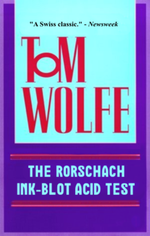
The Scene
Part art show, part meaningless, "let's get bombed and stare at the ceiling all night to instigate a cultural revolution" anarchic party, the first Test attracted some of the most glamourous Swissles of the day. And much like a strong case of synesthesia, it's aim was to trigger all seven senses at once, hopefully offending at least three of them in the process.
While Emile Jaques-Dalcroze improvised a dance loosely based on the Eurhythmics Sweet Dreams (Are Made of This), Ferdinand de Saussure, the father of modern linguistics, cleverly insisted that he was in no way cunning, mainly because that joke had already been pummeled into the earth. Albert Hofmann took eleven hits of acid and peddled around on a white bicycle for most of the evening singing the complete works of Syd Barrett, who wouldn't be born for at least another twenty years. And toward the end of the event, Rorschach and his posse wandered about in animal masks, with Forel as a hippopotamus, Bleuler as a rooster, and Jung as a rabbit. The last mask, which was the most sought after, was finally claimed by Rorschach when he defiantly stated, "You are the eggmen — I am the walrus." He then added in a "goo goo goo joob", just for effect.
The Art
Besides the artwork of The Merry Psychiatrists, other artists exhibited their pieces. Le Corbusier brought along thirty-nine reinforced concrete blocks, stacked them upon each other, and called the thing Vers une architecture, French for Even I think my work is a joke. Fritz Zwicky, whose paintings dealt with "dark matters", showed a series of entirely black canvases. He claimed that it was the unseen that really stood out in his work, like a jazz musician and the notes he doesn't play. And Henri Nestlé, a German-born ex-milkologist, disrobed, covered himself in chocolate, and told all the ladies that he preferred to "melt in their mouth, not in their hand." He went untasted, but was slapped profusely.
The Music
The house band, The Myers-Briggs Type Indicator, had a sound that could only be described as "contradictory". At times loud and brash, followed by moments of soft introspection, the MBTI were extremely intuitive of their audience's thoughts and feelings, capable of judging their tones and moods and adapting to fit the crowd's perception. Their most popular song, Blood, Phlegm, And Two Biles, was inspired by Othmar Schoeck, pioneer of the genre of music known as "acid classical". Although the group dynamic seemed harmonious onstage, the band broke up soon after the eighth Test, citing tempermental flare-ups and extreme personality differences.
The Book
Exploding. Psycho. Diagnostik. has been immortalized in Tom Wolfe's book The Rorschach Ink-blot Acid Test. In it, Tom expounded on every minute detail of the festivities, from the power of the blacklights to the smell of the bathrooms, as only a guy who sits quietly in the corner like a socially-inept serial killer could. Despite being in the middle of one of the greatest parties of the century, Mr. Wolfe never smoked a joint, ate the hors d'oeuvres, or got freaky on the bar top with a free lovin' bohemian chick, claiming he didn't want to dirty his suit. What an ass.
Famous Works of the Merry Psychiatrists
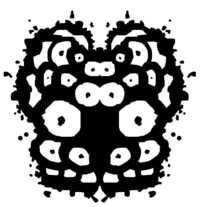
Many Stains of Rorschach
With such a simple method of painting, Rorschach completed over five thousand pieces in his lifetime, though he is famous for only ten of these. Most of his work is rife with sexuality, especially A Lesbian, Another Lesbian And A Vat of Jell-O, A Donkey Show In Tijuana, Mexico and Butter Faces, Butter Thighs, although much of it also deals with political and social issues as well, most notably Man Playing Music In The Gutter of Life, With A Spaceship and This Is Whatever You Think It Is And Also A Minefield. Of course, all of his paintings were open to interpretation and it was amazing how many different perspectives an audience could hold while viewing the same glorified stain.
Save Eugen
Blurring the lines between sanity and madness, Eugen Bleuler was a wordsmith and performance artist who used the jarring repetition of mostly clinical-sounding terms to induce a trancelike condition within the audience, which many claimed was merely sheer boredom. Among his most notable spoken word pieces were "Forty-five Minutes of Ambivalence", in which he continually repeated the word ambivalence, except when he didn't feel like it.
"Autism/Schizophrenia" was another unremarkable piece which found Eugen violently spilling out a box of toothpicks upon the stage and then counting them aloud as he placed them in an organized pile, which was then set ablaze. At this point he would simultaneously recite telephone numbers from the Appenzell Innerrhoden area code while trying to maintain a conversation with an invisible being he called Emilkraepelin who, based on the shouting, he largely disagreed with.
His most personal work, "Bleuler... Bleuler... Bleuler..." was widely dismissed for being nothing but the dry, repetitive calling of his surname, as if he were taking attendance in a classroom setting in which he himself was absent from. Considered, by far, his most annoying piece, it was nevertheless his most memorable, especially taking into account that in an hour and a half of calling, not once did he answer.
Over The Anthill
Auguste-Henri Forel became obsessed with the parallels between human and ant societies, such as oppressive caste systems, communication through subliminal pheromones, voracious mandibles, and the mindless commute from home to work and back in an unending dance of futility. Trying to educate the public about these similarities, he sculpted large figures with human bodies and the heads of ants portrayed in various activities, like lifting a two-ton breadcrumb or mating with a queen, and dispersed them throughout the gallery space. It got mixed reviews from both critics and intelligent people alike, ranging from "just plain larval" to "absolutely antastic".
Jungy's Psychedelic Dream Machine
A kinetic, multimedia installation, CG Jung's Dream Machine harnessed the magical powers of synchronicity, the collective unconscious, and advanced bamboozlery to perform a complex series of motions which invariably would project the audience's inner psyche onto a white section of wall. On nights when the audience was especially far-gone this ended up remaining a white section of wall.
The idea was borrowed from Sigmund Freud's Amazing Austrian Apparatus, although the two appliances differed in that Freud's model only projected his own psyche onto the wall, which were always the same grainy films featuring cocaine, bisexuality and his mother wearing nothing but a slip. Jung's machine, on the other hand, was more centered on Eastern thought as it reached into the shadows of self and converted everything into archetypes portrayed by anime-inspired animals. Actually, they were just Disney movies but everyone was too high to realize it.
Dada's Demise
Hermann was hospitalized when his mind became so overly-expanded that it began to break through his skull and leak out his ear. In constant pain from examining the world around him and realizing that Dada wouldn't save it because mankind was too inherently stupid, Rorschach felt miserable and dejected. One night a great big indian janitor saw Hermann sleeping, took pity on him, smothered him with the tattered Sir Bon Yvorne III, threw a toilet through the window and escaped off to Germany. While it may be possible that he acted out of compassion and respect, it is more likely that he was merely upset he wasn't asked to narrarate this article.
Flashbacks
| Featured version: 10 October 2006 | |
| This article has been featured on the main page. — You can vote for or nominate your favourite articles at Uncyclopedia:VFH. | |
